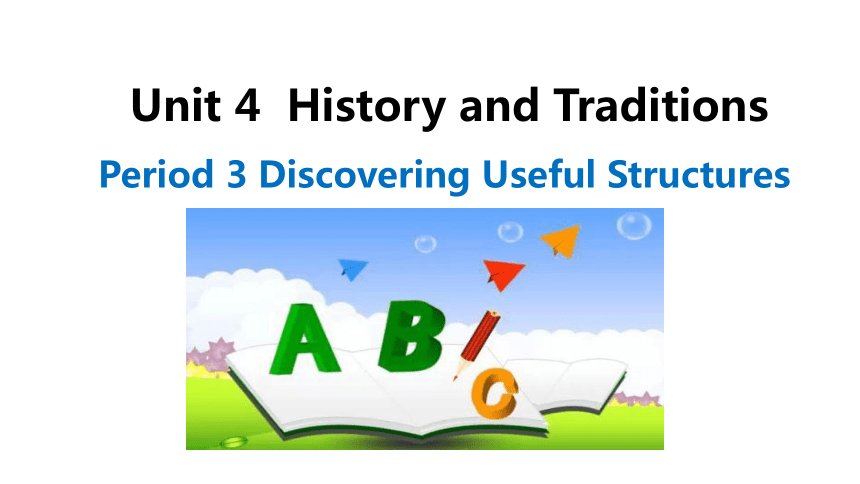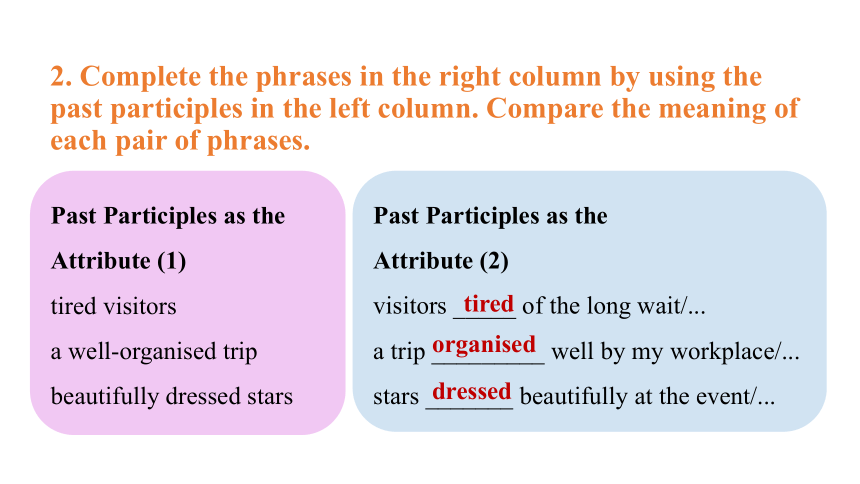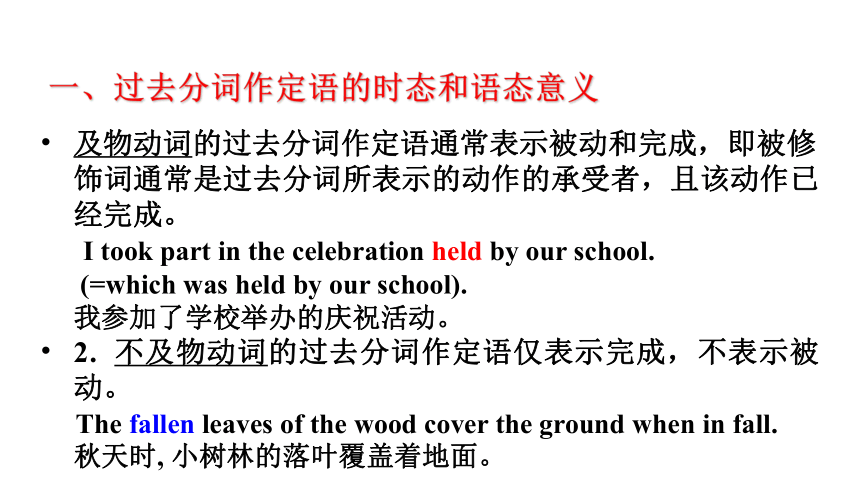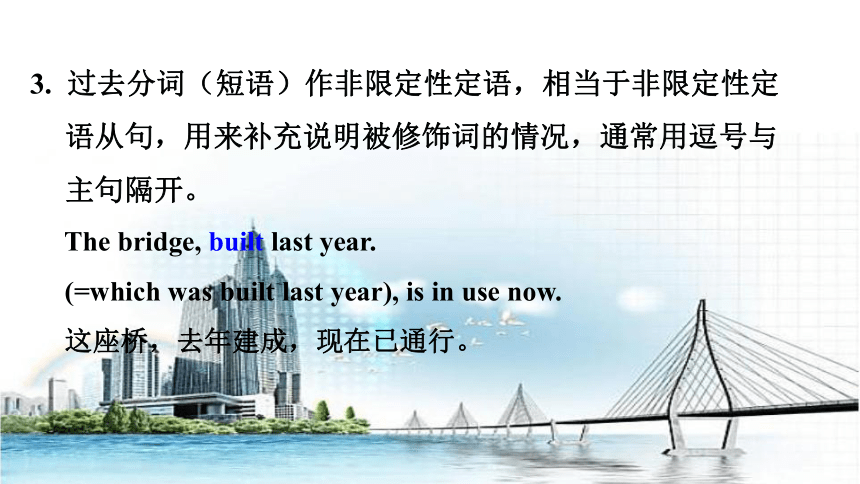人教版(2019)必修 第二册Unit 4 History and traditions Discovering Useful Structures课件(共23张)
文档属性
| 名称 | 人教版(2019)必修 第二册Unit 4 History and traditions Discovering Useful Structures课件(共23张) |  | |
| 格式 | ppt | ||
| 文件大小 | 1.0MB | ||
| 资源类型 | 教案 | ||
| 版本资源 | 人教版(2019) | ||
| 科目 | 英语 | ||
| 更新时间 | 2024-11-14 14:58:20 | ||
图片预览









文档简介
(共23张PPT)
Period 3 Discovering Useful Structures
Unit 4 History and Traditions
Learning aims
To learn the past participles as the attribute and the object complement.
1. Analyse the sentences below in the text and find out the past participles. And then discuss their functions.
Most people just use the shortened name: “the United Kingdom” or “the UK”.
They use the same flag, known as the Union Jack,...
They had castles built all around England,...
as the object complement
as the attribute
as the attribute
Leading-in
The United Kingdom, Great Britain, England— many people are confused by...
They conquered England after the well-known Battle of Hastings in the 11th century.
as the attribute
as the attribute
过去分词或过去分词短语在句中可作定语或宾语补足语。
Past Participles as the Attribute (1)
tired visitors
a well-organised trip
beautifully dressed stars
2. Complete the phrases in the right column by using the past participles in the left column. Compare the meaning of each pair of phrases.
Past Participles as the
Attribute (2)
visitors _____ of the long wait/...
a trip _________ well by my workplace/...
stars _______ beautifully at the event/...
tired
organised
dressed
Past Participles (1)
过去分词一般表示完成的和被动的动作。
规则动词的过去分词由动词原形加-ed构成;不规则动词的过去分词没有统一的构成规则。
过去分词一般在句子中可以用作定语(the attribute)、宾语补足语(the object complement)、表语(the predicative)和状语(the adverbial),但不能单独构成谓语。
Grammar
及物动词的过去分词作定语通常表示被动和完成,即被修 饰词通常是过去分词所表示的动作的承受者,且该动作已经完成。
I took part in the celebration held by our school.
(=which was held by our school).
我参加了学校举办的庆祝活动。
2. 不及物动词的过去分词作定语仅表示完成,不表示被动。
The fallen leaves of the wood cover the ground when in fall.
秋天时, 小树林的落叶覆盖着地面。
一、过去分词作定语的时态和语态意义
3. 过去分词(短语)作非限定性定语,相当于非限定性定语从句,用来补充说明被修饰词的情况,通常用逗号与主句隔开。
The bridge, built last year.
(=which was built last year), is in use now.
这座桥,去年建成,现在已通行。
二、过去分词作定语时的位置
1. 一般情况下,单个过去分词作前置定语,即放在被修饰词之前。有时为了表示强调,也可放在被修饰词之后。如:
The polluted water was to blame for the spread of cholera.
污染了的水造成了霍乱的传播。
2. 过去分词短语作定语时往往作后置定语,即放在被修饰词之后。
The river polluted by daily waste is now dirty and smelly.
被日常垃圾污染的河水现在脏且难闻。
【即学即练】
1. The first engine____________(drive)by steam was invented by James Walt, an inventor, engineer, and chemist.
2. It is dangerous for the villagers to drink from wells ____________(pollute) with poisonous chemicals.
3. Rosemary shares her _____________(pack) lunch with two friends every day.
4. Westminster Abbey is a typical Gothic church, ____________(complete) in the 10th century.
5. These are English text books specially ___________(design) for primary school students.
6. In the car park of the National Museum there are parking spaces___________(reserve) for people with disabilities.
driven
polluted
packed
completed
designed
reserved
能够接动词过去分词作宾补的动词有以下四类:
1.表示感觉或心理状态的动词。如:see,watch,observe,look at,hear, listen to,feel,notice,find等;如:
I heard the song sung in English. 我听到有人用英语唱过这首歌。
He found his hometown greatly changed. 他发现他的家乡变化很大。
the song为宾语,sung为宾语补足语,两者之间为动宾关系
his hometown为宾语,changed为宾语补足语,两者之间为动宾关系
三、过去分词作宾语补足语
2.表示"使..."意义的动词。如∶have,make,get,keep,leave等;如:
I'll have my hair cut tomorrow. 明天我要理发。
He got his tooth pulled out yesterday. 他昨天把牙拔了。
Don't leave those things undone. 不要留下那些事情不做。
宾语和宾语补足语之间为被动关系,为动宾关系
3.表示"希望"、"要求"意义的动词,如∶ would like,order,want,wish等;
I would like this matter settled at once. 我希望此事立刻得到解决。
I wish my homework finished before five o'clock. 我希望 5 点前完成我的作业。
4.介词with+宾语+过去分词
The outside sight looks beautiful with everything covered with snow.
白雪覆盖着大地,屋外景色迷人。
宾语和宾语补足语之间为被动关系,为动宾关系
(1) Judy and I had our car parked in an underground car park near
Trafalgar Square, where we could get our car battery charged.
(2) When we finally reached the service desk to ask for audio guides,
we heard it announced that there were no audio guides left.
(3) We found ourselves very surprised by the large number of visitors
and the amount of noise at the entrance of the national Gallery.
1.Read the sentences and underline the -ed form as the object complement.
【即学即练】
(4)Judy had her eyes fixed on Van Gogh's Sunflowers. It was hard to approach the painting as there were so many people around.
(5)She had a copy of the painting boxed to ensure that it was delivered safely.
The new product finally passed the required test.
It is a house built by the Romans.
He got his tooth pulled out yesterday.
Unfortunately he had his leg broken yesterday.
2.Read the sentences and match.
past participle as the object complement
past participle as the attribute
__________________________________
_____________________
①
②
③
(1) John received an invitation to dinner, and with his work ___________(finish), he gladly accepted it.
(2)Jenny hopes that Mr Smith will suggest a good way to have her written English ____________ (improve) in a short period.
(3) He is very popular among his students as he always tries to make them ___________(interest) in his lectures.
(4) You should understand the traffic rule by now. You’ve had it ___________often enough.
finished
improved
interested
explained
3. Fill in the blanks.
过去分词作定语和宾语补足语
过去分词作定语
位置
1.单个过去分词作前置定语,但有时为了强调也可放于被修饰词之后;过去分词短语作后置定语,作用相当于定语从句。
2.如果被修饰的词是由every/some/any/no与thing/body/one所构成的复合代词或指示代词those等,单个过去分词或过去分词短语都放在被修饰词的后面。
3.有些过去分词,如left(剩余的),concerned(有关的)等,习惯用作后置定语。
意义
1.及物动词的过去分词作定语通常表示被动和完成, 即被修饰词通常是过去分词所表示的动作的承受者, 且该动作已经完成。
2.不及物动词的过去分词作定语仅表示完成, 不表示被动。
3.过去分词(短语)作非限制性定语, 相当于非限制性定语从句, 用来补充说明被修饰词的情况, 通常用逗号与主句隔开。
过去分词作宾语补足语
1. 用于feel, find, hear, notice, see, smell, observe, watch, think等表示感觉或心理状态的动词后作宾语补足语。
2. 用于get, have, make, keep, leave等使役动词后作宾语补足语。
3.用在“with+宾语+宾补”结构中,宾语与过去分词在逻辑上存在被动关系。这一结构通常在句中作时间、方式、条件、原因等状语。
4.用在like,hate,want,wish,expect, order等表示爱憎、意愿、命令等动词后面作宾语补足语。
Summary
Ⅰ.单句语法填空
(1) She was glad to see her child well ___________(take) care of.
(2) After a knock at the door, the child heard his mother’s voice _________ (call) him.
(3) From the dates _________(mark) on the gold coin, we decided that it was made five hundred years ago.
(4) “Things ______ (lose) never come again!” I couldn’t help talking to myself.
taken
calling
marked
lost
(5 )The Town Hall ____________ in the 1800’s was the most outstanding
building at that time.
(6) The next thing he saw was smoke _________ (rise) from behind the house.
(7) A cook will be immediately fired if he was found ________(smoke) in
kitchen.
(8) She held her hands _____________(press)pressed against her face.
(9) He won’t like such questions ___________(discuss) at the meeting
(10) Alexander tried to get his work __________ (recognize) in the medical
circles.
completed
rising
smoking
pressed
discussed
recognized
1. Loch Ness was surrounded by beautiful natural landscape, which made it look amazing.
2. Carl and his friends stayed with a generous family who offered them bread with butter and honey that was homemade.
Ⅱ.用过去分词作定语改写句子
Loch Ness surrounded by beautiful natural landscape looks amazing.
Carl and his friends stayed with a generous family who offered them homemade bread with butter and honey.
3. The family's ancestors once attended to soldiers who were wounded in the First World War.
4. The young people were attracted by the legend of Loch Ness. They watched over the lake with their cameras and binoculars, which were positioned on the hill.
The family's ancestors once attended to wounded soldiers in the First World War.
The young people attracted by the legend of Loch Ness watched over the lake with their cameras and binoculars positioned on the hill.
Difficult circumstances serve as a textbook of life for people.
困难坎坷是人们的生活教科书。
Period 3 Discovering Useful Structures
Unit 4 History and Traditions
Learning aims
To learn the past participles as the attribute and the object complement.
1. Analyse the sentences below in the text and find out the past participles. And then discuss their functions.
Most people just use the shortened name: “the United Kingdom” or “the UK”.
They use the same flag, known as the Union Jack,...
They had castles built all around England,...
as the object complement
as the attribute
as the attribute
Leading-in
The United Kingdom, Great Britain, England— many people are confused by...
They conquered England after the well-known Battle of Hastings in the 11th century.
as the attribute
as the attribute
过去分词或过去分词短语在句中可作定语或宾语补足语。
Past Participles as the Attribute (1)
tired visitors
a well-organised trip
beautifully dressed stars
2. Complete the phrases in the right column by using the past participles in the left column. Compare the meaning of each pair of phrases.
Past Participles as the
Attribute (2)
visitors _____ of the long wait/...
a trip _________ well by my workplace/...
stars _______ beautifully at the event/...
tired
organised
dressed
Past Participles (1)
过去分词一般表示完成的和被动的动作。
规则动词的过去分词由动词原形加-ed构成;不规则动词的过去分词没有统一的构成规则。
过去分词一般在句子中可以用作定语(the attribute)、宾语补足语(the object complement)、表语(the predicative)和状语(the adverbial),但不能单独构成谓语。
Grammar
及物动词的过去分词作定语通常表示被动和完成,即被修 饰词通常是过去分词所表示的动作的承受者,且该动作已经完成。
I took part in the celebration held by our school.
(=which was held by our school).
我参加了学校举办的庆祝活动。
2. 不及物动词的过去分词作定语仅表示完成,不表示被动。
The fallen leaves of the wood cover the ground when in fall.
秋天时, 小树林的落叶覆盖着地面。
一、过去分词作定语的时态和语态意义
3. 过去分词(短语)作非限定性定语,相当于非限定性定语从句,用来补充说明被修饰词的情况,通常用逗号与主句隔开。
The bridge, built last year.
(=which was built last year), is in use now.
这座桥,去年建成,现在已通行。
二、过去分词作定语时的位置
1. 一般情况下,单个过去分词作前置定语,即放在被修饰词之前。有时为了表示强调,也可放在被修饰词之后。如:
The polluted water was to blame for the spread of cholera.
污染了的水造成了霍乱的传播。
2. 过去分词短语作定语时往往作后置定语,即放在被修饰词之后。
The river polluted by daily waste is now dirty and smelly.
被日常垃圾污染的河水现在脏且难闻。
【即学即练】
1. The first engine____________(drive)by steam was invented by James Walt, an inventor, engineer, and chemist.
2. It is dangerous for the villagers to drink from wells ____________(pollute) with poisonous chemicals.
3. Rosemary shares her _____________(pack) lunch with two friends every day.
4. Westminster Abbey is a typical Gothic church, ____________(complete) in the 10th century.
5. These are English text books specially ___________(design) for primary school students.
6. In the car park of the National Museum there are parking spaces___________(reserve) for people with disabilities.
driven
polluted
packed
completed
designed
reserved
能够接动词过去分词作宾补的动词有以下四类:
1.表示感觉或心理状态的动词。如:see,watch,observe,look at,hear, listen to,feel,notice,find等;如:
I heard the song sung in English. 我听到有人用英语唱过这首歌。
He found his hometown greatly changed. 他发现他的家乡变化很大。
the song为宾语,sung为宾语补足语,两者之间为动宾关系
his hometown为宾语,changed为宾语补足语,两者之间为动宾关系
三、过去分词作宾语补足语
2.表示"使..."意义的动词。如∶have,make,get,keep,leave等;如:
I'll have my hair cut tomorrow. 明天我要理发。
He got his tooth pulled out yesterday. 他昨天把牙拔了。
Don't leave those things undone. 不要留下那些事情不做。
宾语和宾语补足语之间为被动关系,为动宾关系
3.表示"希望"、"要求"意义的动词,如∶ would like,order,want,wish等;
I would like this matter settled at once. 我希望此事立刻得到解决。
I wish my homework finished before five o'clock. 我希望 5 点前完成我的作业。
4.介词with+宾语+过去分词
The outside sight looks beautiful with everything covered with snow.
白雪覆盖着大地,屋外景色迷人。
宾语和宾语补足语之间为被动关系,为动宾关系
(1) Judy and I had our car parked in an underground car park near
Trafalgar Square, where we could get our car battery charged.
(2) When we finally reached the service desk to ask for audio guides,
we heard it announced that there were no audio guides left.
(3) We found ourselves very surprised by the large number of visitors
and the amount of noise at the entrance of the national Gallery.
1.Read the sentences and underline the -ed form as the object complement.
【即学即练】
(4)Judy had her eyes fixed on Van Gogh's Sunflowers. It was hard to approach the painting as there were so many people around.
(5)She had a copy of the painting boxed to ensure that it was delivered safely.
The new product finally passed the required test.
It is a house built by the Romans.
He got his tooth pulled out yesterday.
Unfortunately he had his leg broken yesterday.
2.Read the sentences and match.
past participle as the object complement
past participle as the attribute
__________________________________
_____________________
①
②
③
(1) John received an invitation to dinner, and with his work ___________(finish), he gladly accepted it.
(2)Jenny hopes that Mr Smith will suggest a good way to have her written English ____________ (improve) in a short period.
(3) He is very popular among his students as he always tries to make them ___________(interest) in his lectures.
(4) You should understand the traffic rule by now. You’ve had it ___________often enough.
finished
improved
interested
explained
3. Fill in the blanks.
过去分词作定语和宾语补足语
过去分词作定语
位置
1.单个过去分词作前置定语,但有时为了强调也可放于被修饰词之后;过去分词短语作后置定语,作用相当于定语从句。
2.如果被修饰的词是由every/some/any/no与thing/body/one所构成的复合代词或指示代词those等,单个过去分词或过去分词短语都放在被修饰词的后面。
3.有些过去分词,如left(剩余的),concerned(有关的)等,习惯用作后置定语。
意义
1.及物动词的过去分词作定语通常表示被动和完成, 即被修饰词通常是过去分词所表示的动作的承受者, 且该动作已经完成。
2.不及物动词的过去分词作定语仅表示完成, 不表示被动。
3.过去分词(短语)作非限制性定语, 相当于非限制性定语从句, 用来补充说明被修饰词的情况, 通常用逗号与主句隔开。
过去分词作宾语补足语
1. 用于feel, find, hear, notice, see, smell, observe, watch, think等表示感觉或心理状态的动词后作宾语补足语。
2. 用于get, have, make, keep, leave等使役动词后作宾语补足语。
3.用在“with+宾语+宾补”结构中,宾语与过去分词在逻辑上存在被动关系。这一结构通常在句中作时间、方式、条件、原因等状语。
4.用在like,hate,want,wish,expect, order等表示爱憎、意愿、命令等动词后面作宾语补足语。
Summary
Ⅰ.单句语法填空
(1) She was glad to see her child well ___________(take) care of.
(2) After a knock at the door, the child heard his mother’s voice _________ (call) him.
(3) From the dates _________(mark) on the gold coin, we decided that it was made five hundred years ago.
(4) “Things ______ (lose) never come again!” I couldn’t help talking to myself.
taken
calling
marked
lost
(5 )The Town Hall ____________ in the 1800’s was the most outstanding
building at that time.
(6) The next thing he saw was smoke _________ (rise) from behind the house.
(7) A cook will be immediately fired if he was found ________(smoke) in
kitchen.
(8) She held her hands _____________(press)pressed against her face.
(9) He won’t like such questions ___________(discuss) at the meeting
(10) Alexander tried to get his work __________ (recognize) in the medical
circles.
completed
rising
smoking
pressed
discussed
recognized
1. Loch Ness was surrounded by beautiful natural landscape, which made it look amazing.
2. Carl and his friends stayed with a generous family who offered them bread with butter and honey that was homemade.
Ⅱ.用过去分词作定语改写句子
Loch Ness surrounded by beautiful natural landscape looks amazing.
Carl and his friends stayed with a generous family who offered them homemade bread with butter and honey.
3. The family's ancestors once attended to soldiers who were wounded in the First World War.
4. The young people were attracted by the legend of Loch Ness. They watched over the lake with their cameras and binoculars, which were positioned on the hill.
The family's ancestors once attended to wounded soldiers in the First World War.
The young people attracted by the legend of Loch Ness watched over the lake with their cameras and binoculars positioned on the hill.
Difficult circumstances serve as a textbook of life for people.
困难坎坷是人们的生活教科书。
